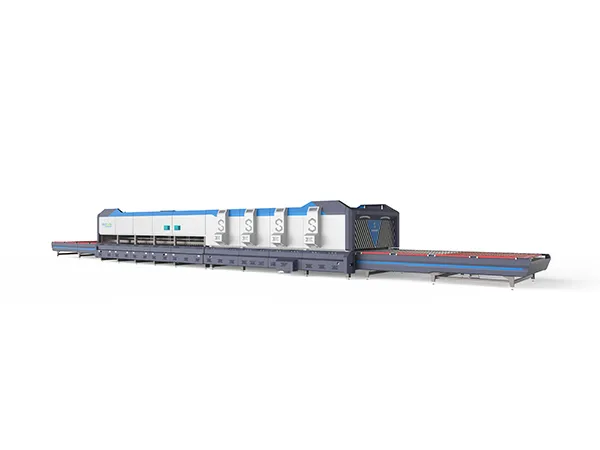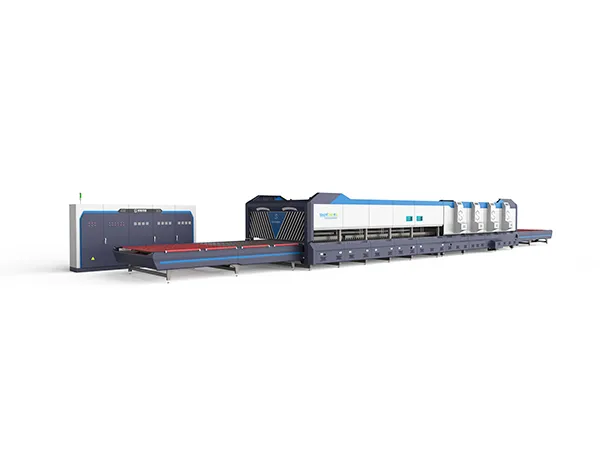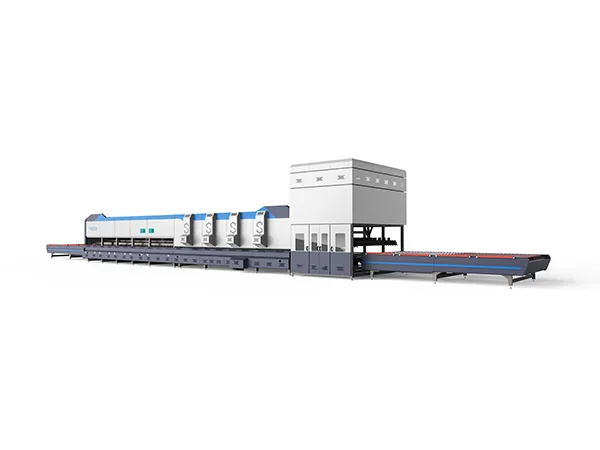The glass tempering furnace is an industrial heating equipment, also known as a glass tempering unit, tempering furnace, tempering equipment or tempering unit, etc. It mainly forms a compressive stress layer on the surface of the glass and a tensile stress layer inside by physical or chemical methods, thereby improving the strength and safety of the glass. The following is a detailed introduction to the glass tempering furnace:
Glass Tempering Furnace Introduction

1. Working principle
The working principle of the glass tempering furnace mainly includes the following steps:
Heating: In the tempering furnace, the glass is placed in the heating chamber. The heating element gradually increases the temperature in the furnace through resistance heating or other means, so that the surface and inside of the glass reach the tempering temperature (usually about 650℃).
Wind quenching cooling: Once the glass reaches the tempering temperature, the wind quenching device will quickly blow cooling air to the surface of the glass, so that the surface cools rapidly, while the inside remains at a high temperature. This creates a temperature difference between the surface and the inside, thereby generating compressive stress on the surface of the glass and tensile stress inside.
Internal cooling and stress balance: After wind quenching cooling, the temperature inside the glass begins to slowly drop and gradually become uniform. In this process, tensile stress is formed inside the glass, which is balanced with the compressive stress on the surface to form a strong overall structure.
2. Main features
High efficiency: The glass tempering furnace has a fast processing speed, which can greatly shorten the production cycle and improve production efficiency.
Good stability: It has the characteristics of high temperature control accuracy and stable processing quality, which can ensure that the products processed by glass are of higher quality.
Large processing range: It is suitable for the processing of a variety of glass products, such as architectural glass, furniture glass, automotive glass, etc.
Strong explosion-proof: The tempered glass has strong explosion-proof performance. Even if it is broken, it will not form sharp fragments like ordinary glass, which improves safety.
Automation control: Most glass tempering furnaces use an automatic control system to achieve full-process automatic operation, including temperature control, heating, cooling, etc., which improves production efficiency and consistency.
Energy saving and environmental protection: The equipment adopts advanced energy-saving technologies, such as energy recovery systems, to minimize energy consumption and achieve energy-saving and environmentally friendly production.

3. Types and classifications
Glass tempering furnaces can be classified according to different standards:
According to the characteristics of the heating method: forced convection heating tempering equipment and radiation heating tempering equipment.
According to the heating method: electric heating glass tempering furnace and gas heating glass tempering furnace.
According to the structure and functional characteristics of the equipment, it can be divided into: flat tempering equipment, curved tempered glass equipment, continuous tempering equipment, two-way tempering equipment, combined tempering equipment, unequal arc curved tempering equipment, hanging furnace, etc.
4. Application scenarios
Glass tempering furnaces are widely used in many fields, including home, solar energy, furniture, automobiles, ships, building curtain walls, etc., providing the required horizontal tempered glass for these fields.
5. The main types of glass products that can be processed by glass tempering furnaces:
(1) Architectural decorative glass
Architectural curtain wall glass: used for exterior wall decoration of high-rise buildings, commercial complexes, etc., with the characteristics of beauty, safety, and weather resistance.
Door and window glass: Tempered door and window glass is more durable and can effectively prevent breakage and injury, thereby improving the safety of homes and offices.
(2) Civil furniture glass
Dining table glass: The surface of tempered glass dining table is smooth, easy to clean, and can withstand a certain weight and impact.
Tea table glass: Tempered glass tea table is also safe, beautiful, and practical, suitable for various home styles.
Bathroom glass: For example, shower room glass is more durable and less likely to break after tempering, which improves the safety of bathroom use.
(3) Home appliance glass
Oven glass: used in oven doors and other parts, can withstand high temperatures and is not easily deformed, ensuring the safety of oven use.
Refrigerator glass: Some high-end refrigerators use tempered glass panels, which are not only beautiful but also durable.
(4) Automobile glass
Windshield glass: Tempered windshield glass has higher strength and safety, which can effectively protect the safety of drivers and passengers.
Car window glass: It is also treated with tempering technology to improve the impact resistance and safety of car window glass.
(5) Special purpose glass
Low-E glass: It has excellent heat insulation and thermal insulation properties and is widely used in the field of building energy conservation. Glass tempering furnaces have unique advantages in processing Low-E glass.
Ultra-thin glass: Such as ultra-thin tempered glass, which can be used in advanced industrial instruments, civil appliances, lamps and lighting, etc., has the characteristics of lightness, beauty and durability.
Double-curved glass: It is suitable for some specially designed buildings and furniture, and can show unique visual effects.

6. Strength of tempered glass
(1) Strength range
The compressive strength of tempered glass can generally reach more than 125MPa, which is 4 to 5 times the strength of ordinary glass. In some data, the strength of tempered glass can even reach more than 200MPa, which is equivalent to 5 to 10 times the strength of ordinary glass. This huge increase in strength is due to the fact that during the manufacturing process of tempered glass, by heating it to more than 600 degrees and then cooling it rapidly, a layer of compressive stress is formed on the surface of the glass and a layer of tensile stress is formed inside, thereby enhancing its overall strength and toughness.
(2) Impact resistance
In addition to compressive strength, tempered glass also exhibits extremely high impact resistance. Experiments show that when measured by the steel ball method, a 0.8kg steel ball falls from a height of 1.2m and the tempered glass can still remain intact. This feature enables tempered glass to resist breakage more effectively when subjected to external force, improving the safety of use.
(3) Elasticity
The elasticity of tempered glass is also much greater than that of ordinary glass. For example, a piece of tempered glass measuring 1200mm×350mm×6mm can bend up to 100mm after being subjected to force, and it can still return to its original shape when the external force is removed. When ordinary glass is subjected to the same external force, the bending deformation can only be a few millimeters and it is difficult to return to its original shape.
(4) Other characteristics
In addition to strength and impact resistance, tempered glass also has some other excellent properties. For example, it has a certain degree of transparency and can absorb a certain amount of ultraviolet rays; at the same time, due to the compressive stress layer formed on the surface, the tempered glass appears granular when broken rather than sharp fragments, thereby reducing the risk of fragments injuring people.
7. Precautions
When using a glass tempering furnace, the following matters need to be paid attention to to ensure safe production:
When adjusting key components of the equipment, ensure that the equipment has stopped running.
Check the operating status of the equipment regularly to prevent accidents caused by malfunctions.
Before the equipment is heated up, check whether the relevant components are intact and ensure that they are correct before heating.
Strictly produce according to the processing capacity of the equipment to avoid overload operation.
In summary, the glass tempering furnace is an efficient, stable and widely used industrial equipment. It improves the strength and safety of glass through physical or chemical methods and plays an important role in many fields.










